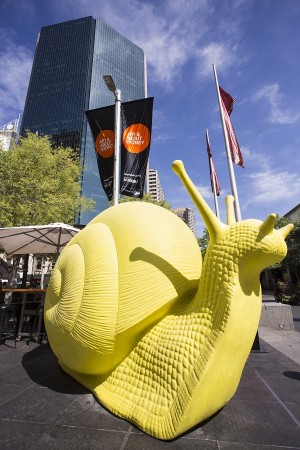Take Five: Slowing Down in Contemplation with ‘Snailovation’
Giant red and yellow snails have invaded the city of Sydney, Australia. Now, before those of you who are either residing or visiting the land down under decide to turn on your heel and run in the opposite direction, afraid of an encounter with a slimy creature not too far off from the size of King-Kong, or perhaps whip out a fork and knife for a scrumptious feast of escargot, as if you were the King or Queen of France, there is something you should know about these brightly-hued creatures.
Strewn across 13 streets, with key locations around Queens Square, Hyde Park and Martin Place, the 24 life-sized mollusks, made out of recyclable materials, are part of a public art installation for the Art & About Festival in Sydney. Meant to evoke feelings of contemplation whilst slowing one’s life down momentarily, the piece, entitled Snailovation, stands as a reminder and commentary on the action one ought to take when it comes to the environment.
Created by the artistic collective Cracking Art Group, the critters, remarkably, aren’t on public display for the first time. According to Art & About, they first made their appearance in 2010 at the renowned Miami Art Basel. Since they came into fruition in 1993, the international artistic group (made up of six artists), has been focusing in on bringing animal sculptures to the outside world from turtles at the Venice Biennale in 2001, to rabbits in Paris in 2009, as part of a collaborative effort with Marc Jacobs. Hoping to elicit those same feelings of respect and curiosity in adults, Enrico Furlan, a member of the Cracking Art Group, spoke to GALO about the importance of social activism presiding in their art.
On the representative nature of the snails and the use of the same animal as a symbol of environmental awareness:
Enrico Furlan: In a world that is always in a hurry, the snails invite people to adopt a rhythm that allows them to observe and listen more carefully. We use the same animal several times, in different places, because we believe you have to repeat an idea many times in order to affirm it, before it is heard in its entirety.
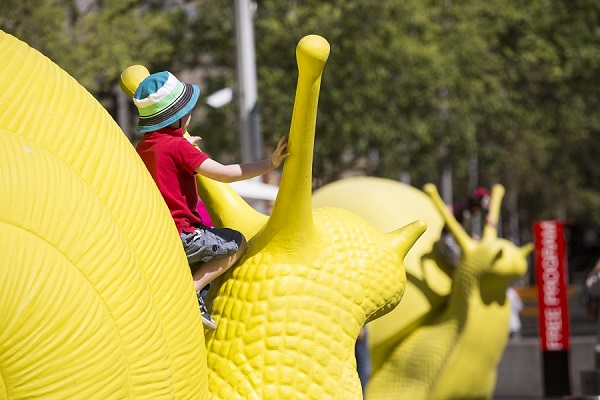
A child sits atop a yellow snail, part of the Snailovation project during the Art & About Festival in Sydney, Australia. Photo Courtesy of: City of Sydney.
On the choice of attention-grabbing colors and the intended level of interactivity with the art:
EF: The color is a reminder of childhood toys. Our desire is to establish an interaction between the public and our works, a “game” of sorts that fills our creative attention. Children always seem to be the first fans of our installations, but thanks to social networks and photos posted on our blog, we often observe the same reaction from adults. The colorful snails create an immediate empathy, and our desire to create a sense of play is always achieved.
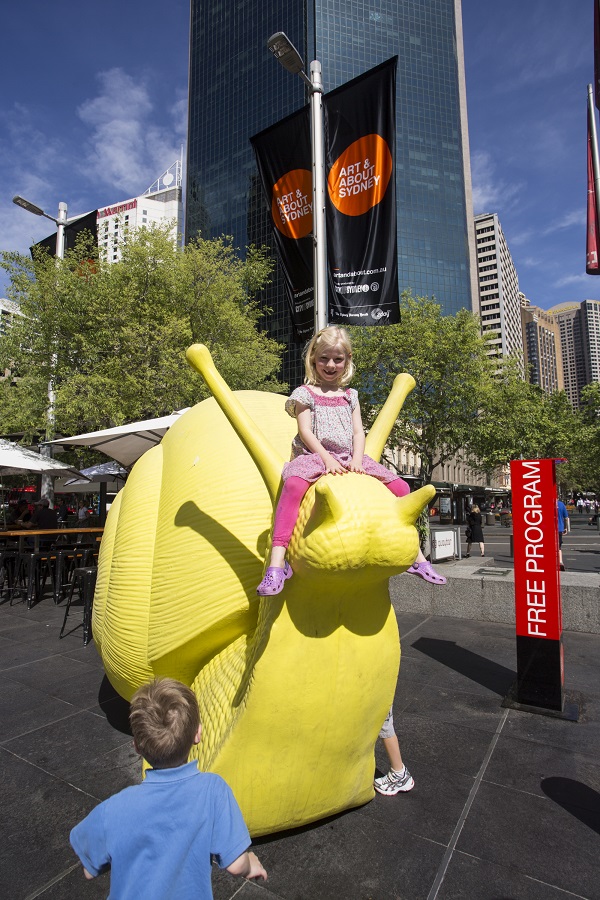
A child sits atop a yellow snail, part of the Snailovation project during the Art & About Festival in Sydney, Australia. Photo Courtesy of: City of Sydney.
On the role of the artist in bringing awareness to that which is affecting our everyday lives, whether it may be politics, the environment/global warming, or technological advancements:
EF: It is not necessary for artists to be responsible for the world around them. The artist invents worlds, and what is important in creating an artwork is to communicate a personal vision. For example, a tree can be illustrated countless times by different artists, and each time you see it in a different way. It is also important to provide diversity — then you need not be political or social commentators or philosophers. We have decided to support our works with a social meaning, but it does not mean that those who do not are on the wrong track.
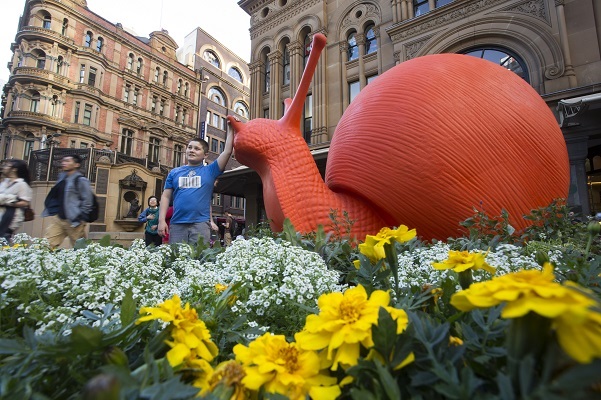
A child poses with a red snail, part of the Snailovation project during the Art & About Festival in Sydney, Australia. Photo Courtesy of: City of Sydney.
On the materials used for the snails and recycling the artwork back into the environment:
EF: Our sculptures are made from recyclable, non-toxic plastic. And usually, when the installations are finished, they are broken down into pieces, chopped-up and reprocessed into plastic powder, which we then use to create other works. Our next project will involve producing items of furniture with the material that comes from our recycled sculptures.
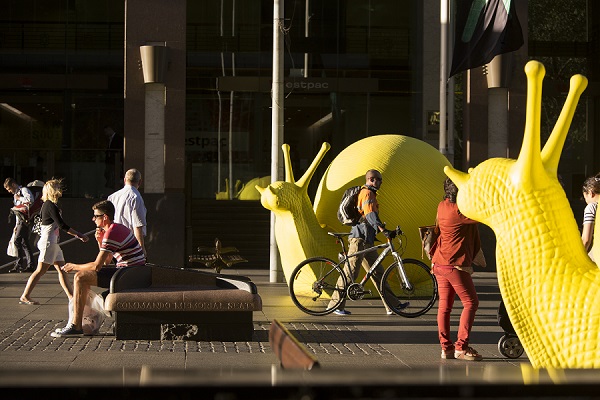
The Snailovation project during the Art & About Festival in Sydney, Australia. Photo Courtesy of: City of Sydney.
On where the snails will travel to next and a glimpse at the newest project:
EF: The snails will reappear at the end of the year in New York, while in Italy, frogs will invade the center of Bologna.
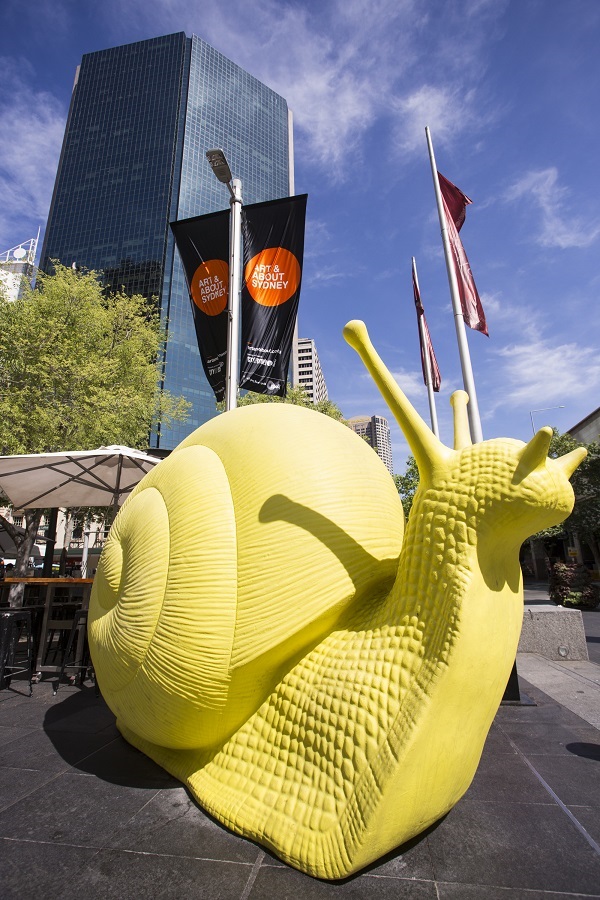
The Snailovation project during the Art & About Festival in Sydney, Australia. Photo Courtesy of: City of Sydney.
“Snailovation” can be viewed throughout the streets of Sydney through October 20, 2013. For more information, inclusive of specific locations, please visit http://www.artandabout.com.au/festival-program/snailovation/.

